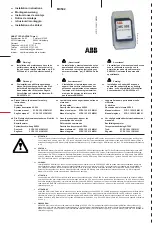
CSM1 Card Storage Module
11
6. Selected Operating Details
6.1 Inserting the Card in the CSM1
One of the features of the CSM1 is that you can either leave the card in the
module and move the module from datalogger to datalogger (or from
datalogger to office), or you can install the module with the datalogger and
transport the memory cards between sites. Whichever is your chosen method of
use, it is critical that the card is inserted into the module correctly.
When plugging the card in, please ensure that you push the card in firmly until
it reaches the back of the card connector, i.e. it will go no further. The eject
button on the card slot comes out as the card is pushed in. When the card is
fully inserted, the end of the eject button should be level with the end of the
card.
If the card is plugged into a module which is then connected to a datalogger the
CSM1 validates the status of the card on power-up and reports any errors by
flashing the status LED (see Table 1). If a card is plugged into a CSM1 which
is already connected to a datalogger, similar tests are done on the card and the
status LED flashes with the same meaning. If the LED flashes three times
indicating the card is not plugged in it is possible that you have not inserted it
correctly. To correct this you should remove the card completely and reinsert
it.
6.2 Response of CSM1 on Detection of Full Card Memory
The card memory structure is predefined as 'fill and stop'. This means that data
can be stored in the card until it is determined that it is full. The card is then
marked by the CSM1 as being full and can no longer can be used to store new
data. The card must be erased before it can store new data.
The CSM1 recognizes that a card is full if it reaches the end of available
memory while storing data. At this point the CSM1 changes the indicated
number of available storage locations to zero and marks the card as full.
Further attempts at data storage are not accepted; this is evident when a
datalogger attempts to write data as the 'Write' LED will not illuminate.
This method of marking the card as full can lead to confusion when writing
data to the card with the CR10 or when storing programs in the card using a
PC. This is because both processes involve transferring blocks of data to the
CSM1, with a validation procedure at the end of the transfer process.
In the case of the CR10 data, the CSM1 accepts data from the datalogger as a
complete block and writes it to the card as it receives the block. However, it
only updates its internal data pointers to indicate it has new data at the end of a
transmission from the CR10. Also, the CR10 only updates its own Storage
Module Pointer (SPTR) after a signal from the CSM1 that it has received the
data correctly.
If the CSM1 detects that a card is full while accepting data from a CR10, it
marks the card as full and immediately aborts the receipt of the whole block. It
Содержание CSM1
Страница 20: ...CSM1 Card Storage Module 14 This is a blank page...
Страница 22: ...This is a blank page...
Страница 32: ...This is a blank page...
Страница 33: ...CSMCOM SOFTWARE...
Страница 34: ...This is a blank page...
Страница 48: ...This is a blank page...
Страница 49: ...SMCREAD SOFTWARE...
Страница 50: ...This is a blank page...
Страница 68: ...Appendix A PCMCIA Driver Software Notes A 6 This is a blank page...
Страница 73: ...This is a blank page...
















































